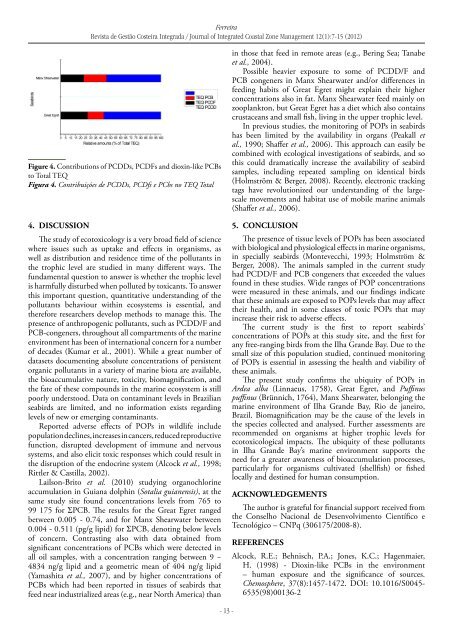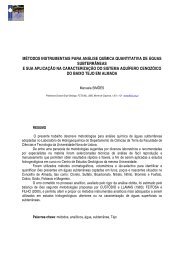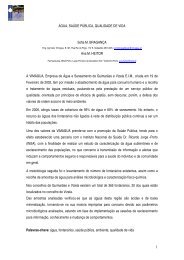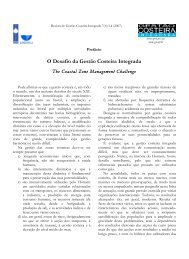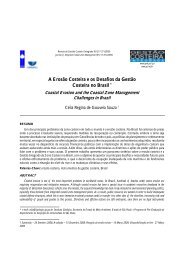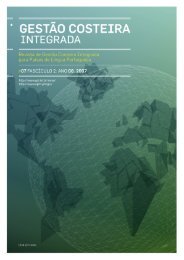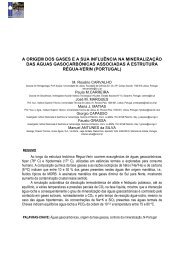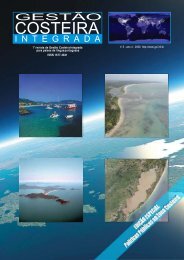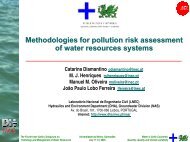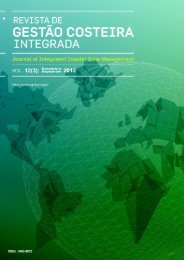Create successful ePaper yourself
Turn your PDF publications into a flip-book with our unique Google optimized e-Paper software.
Ferreira<br />
Revista de Gestão Costeira Integrada / Journal of Integrated Coastal Zone Management 12(1):7-15 (2012)<br />
Figure 4. Contributions of PCDDs, PCDFs and dioxin-like PCBs<br />
to Total TEQ<br />
Figura 4. Contribuições de PCDDs, PCDfs e PCbs no TEQ Total<br />
4. DISCUSSION<br />
The study of ecotoxicology is a very broad field of science<br />
where issues such as uptake and effects in organisms, as<br />
well as distribution and residence time of the pollutants in<br />
the trophic level are studied in many different ways. The<br />
fundamental question to answer is whether the trophic level<br />
is harmfully disturbed when polluted by toxicants. To answer<br />
this important question, quantitative understanding of the<br />
pollutants behaviour within ecosystems is essential, and<br />
therefore researchers develop methods to manage this. The<br />
presence of anthropogenic pollutants, such as PCDD/F and<br />
PCB-congeners, throughout all compartments of the marine<br />
environment has been of international concern for a number<br />
of decades (Kumar et al., 2001). While a great number of<br />
datasets documenting absolute concentrations of persistent<br />
organic pollutants in a variety of marine biota are available,<br />
the bioaccumulative nature, toxicity, biomagnification, and<br />
the fate of these compounds in the marine ecosystem is still<br />
poorly understood. Data on contaminant levels in Brazilian<br />
seabirds are limited, and no information exists regarding<br />
levels of new or emerging contaminants.<br />
Reported adverse effects of POPs in wildlife include<br />
population declines, increases in cancers, reduced reproductive<br />
function, disrupted development of immune and nervous<br />
systems, and also elicit toxic responses which could result in<br />
the disruption of the endocrine system (Alcock et al., 1998;<br />
Rittler & Castilla, 2002).<br />
Lailson-Brito et al. (2010) studying organochlorine<br />
accumulation in Guiana dolphin (Sotalia guianensis), at the<br />
same study site found concentrations levels from 765 to<br />
99 175 for ΣPCB. The results for the Great Egret ranged<br />
between 0.005 - 0.74, and for Manx Shearwater between<br />
0.004 - 0.511 (pg/g lipid) for ΣPCB, denoting below levels<br />
of concern. Contrasting also with data obtained from<br />
significant concentrations of PCBs which were detected in<br />
all oil samples, with a concentration ranging between 9 −<br />
4834 ng/g lipid and a geometric mean of 404 ng/g lipid<br />
(Yamashita et al., 2007), and by higher concentrations of<br />
PCBs which had been reported in tissues of seabirds that<br />
feed near industrialized areas (e.g., near North America) than<br />
in those that feed in remote areas (e.g., Bering Sea; Tanabe<br />
et al., 2004).<br />
Possible heavier exposure to some of PCDD/F and<br />
PCB congeners in Manx Shearwater and/or differences in<br />
feeding habits of Great Egret might explain their higher<br />
concentrations also in fat. Manx Shearwater feed mainly on<br />
zooplankton, but Great Egret has a diet which also contains<br />
crustaceans and small fish, living in the upper trophic level.<br />
In previous studies, the monitoring of POPs in seabirds<br />
has been limited by the availability in organs (Peakall et<br />
al., 1990; Shaffer et al., 2006). This approach can easily be<br />
combined with ecological investigations of seabirds, and so<br />
this could dramatically increase the availability of seabird<br />
samples, including repeated sampling on identical birds<br />
(Holmström & Berger, 2008). Recently, electronic tracking<br />
tags have revolutionized our understanding of the largescale<br />
movements and habitat use of mobile marine animals<br />
(Shaffer et al., 2006).<br />
5. CONCLUSION<br />
The presence of tissue levels of POPs has been associated<br />
with biological and physiological effects in marine organisms,<br />
in specially seabirds (Montevecchi, 1993; Holmström &<br />
Berger, 2008). The animals sampled in the current study<br />
had PCDD/F and PCB congeners that exceeded the values<br />
found in these studies. Wide ranges of POP concentrations<br />
were measured in these animals, and our findings indicate<br />
that these animals are exposed to POPs levels that may affect<br />
their health, and in some classes of toxic POPs that may<br />
increase their risk to adverse effects.<br />
The current study is the first to report seabirds’<br />
concentrations of POPs at this study site, and the first for<br />
any free-ranging birds from the Ilha Grande Bay. Due to the<br />
small size of this population studied, continued monitoring<br />
of POPs is essential in assessing the health and viability of<br />
these animals.<br />
The present study confirms the ubiquity of POPs in<br />
Ardea alba (<strong>Linnaeus</strong>, <strong>1758</strong>), Great Egret, and Puffinus<br />
puffinus (Brünnich, 1764), Manx Shearwater, belonging the<br />
marine environment of Ilha Grande Bay, Rio de janeiro,<br />
Brazil. Biomagnification may be the cause of the levels in<br />
the species collected and analysed. Further assessments are<br />
recommended on organisms at higher trophic levels for<br />
ecotoxicological impacts. The ubiquity of these pollutants<br />
in Ilha Grande Bay’s marine environment supports the<br />
need for a greater awareness of bioaccumulation processes,<br />
particularly for organisms cultivated (shellfish) or fished<br />
locally and destined for human consumption.<br />
Acknowledgements<br />
The author is grateful for financial support received from<br />
the Conselho Nacional de Desenvolvimento Científico e<br />
Tecnológico – CNPq (306175/2008-8).<br />
REFERENCES<br />
Alcock, R.E.; Behnisch, P.A.; Jones, K.C.; Hagenmaier,<br />
H. (1998) - Dioxin-like PCBs in the environment<br />
– human exposure and the significance of sources.<br />
Chemosphere, 37(8):1457-1472. DOI: 10.1016/S0045-<br />
6535(98)00136-2<br />
- 13 -


